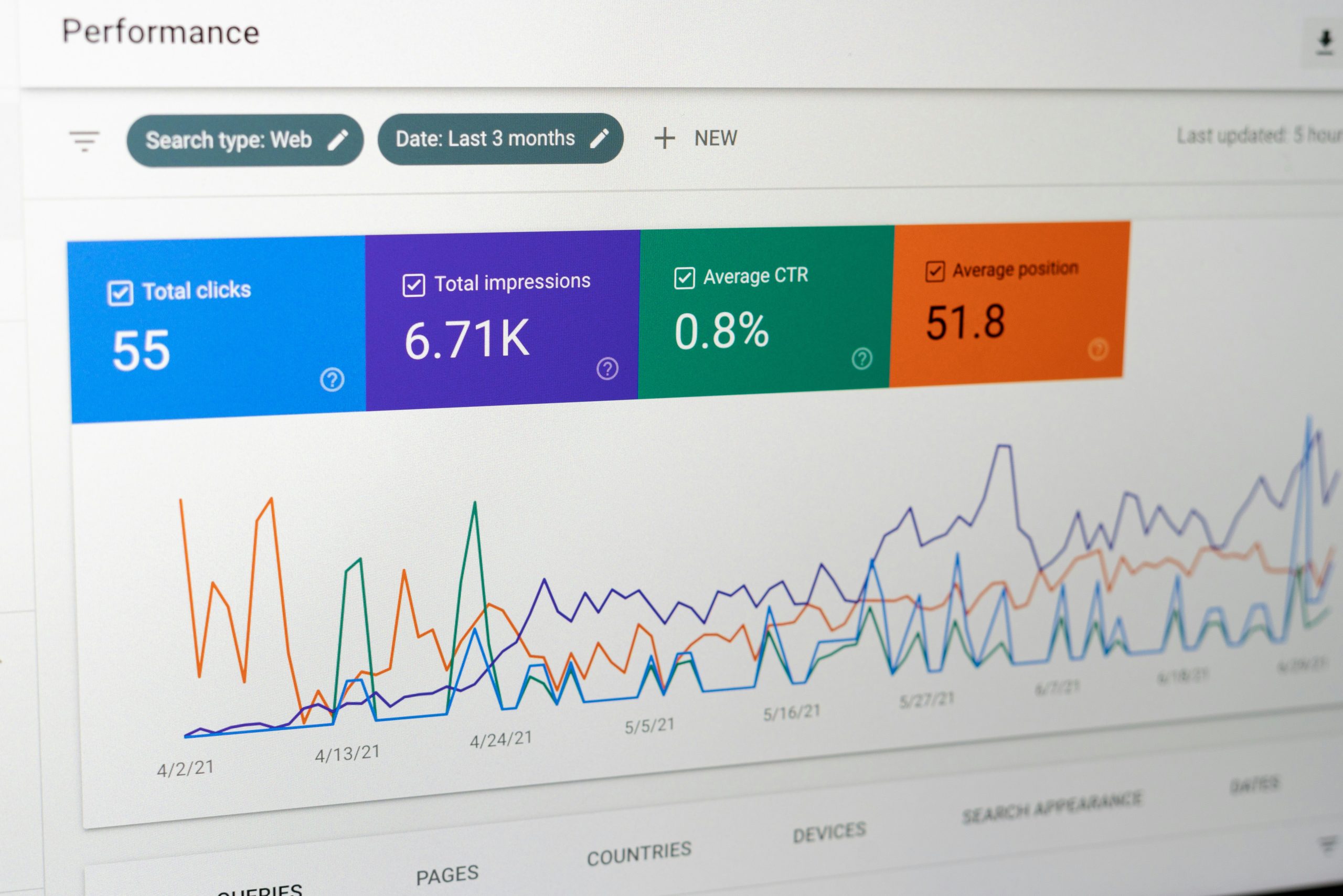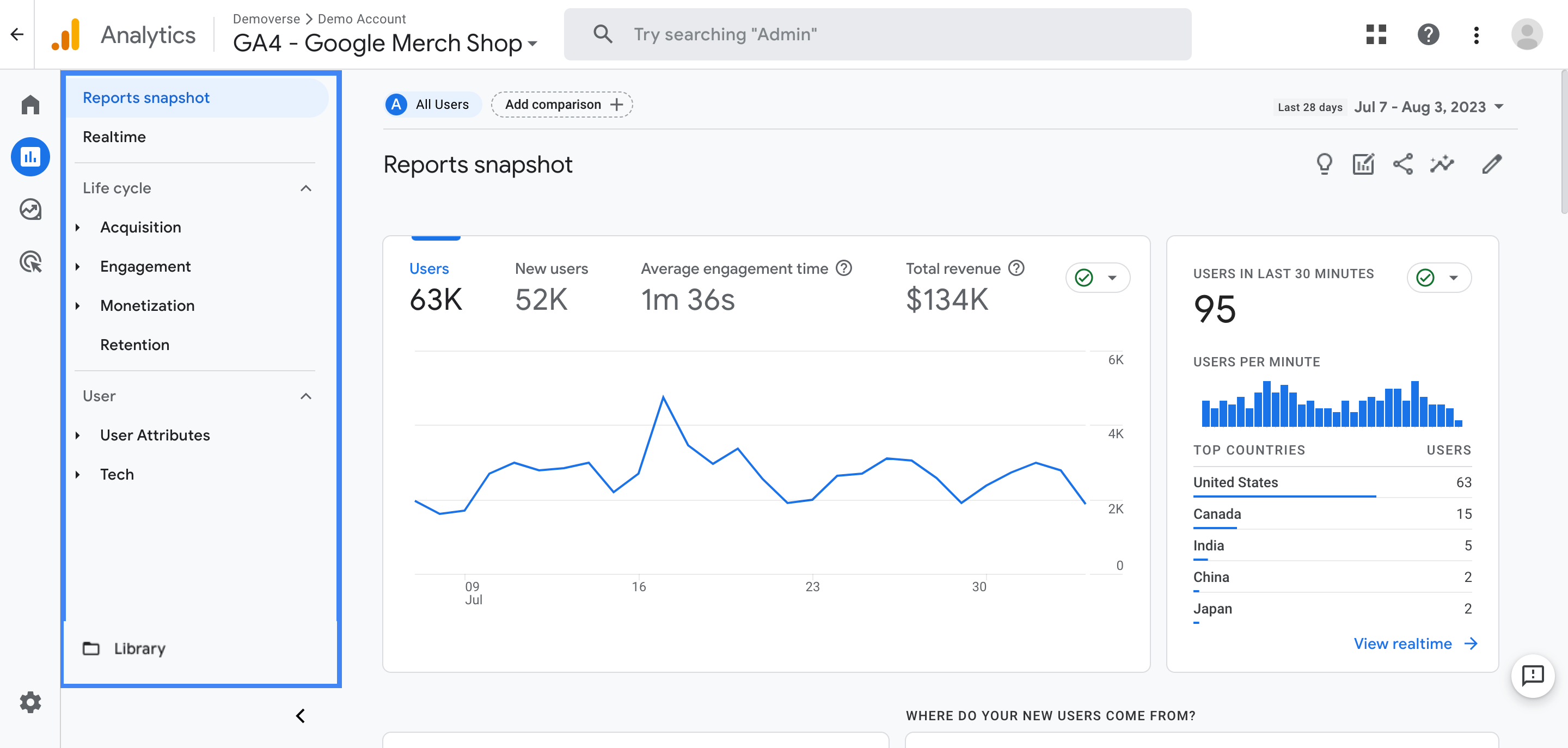Checking your website’s traffic allows you to measure its success and identify areas for improvement. While there are plenty of paid tools out there, there are also a handful of great free tools. Tools like these offer valuable data on your website visitors, top traffic sources, and engagement levels at no cost. The wealth of web traffic data they provide can help you understand your audience better.
Google Search Console
Google Search Console (GSC) is a tool by Google that provides detailed information on your site’s traffic and search performance. There’s no better place to get this data than right from the source. It means you’re guaranteed to get accurate traffic data.
Aside from raw traffic metrics, you can see:
- total impressions,
- Google Search traffic,
- web traffic sources,
- your position search results,
- and your click-through rates.
Information is power when it comes to SEO and digital marketing. It should be the basis of any strategy, and GSC metrics can help with that. GSC also identifies any problems impacting your website’s performance. These might be poor mobile responsiveness or slow loading times. These features make GSC one of the best tools for checking website traffic metrics. Best of all, using the tool to track traffic for multiple websites is completely free and always will be. This is the case with any tool Google provides.

Google Analytics
Google Analytics 4 (GA4) is another tool from Google that’s essential for website owners. This will be the case for as long as Google has such a huge search dominance. GA4 offers more detail on your website’s traffic than GSC. It shows where visitors come from and how they behave on your site. With GA4, you can track website traffic stats like:
- visitor numbers,
- how long people stay on your site,
- the pages they visit,
- and the actions they take.

Understanding your audience is the key to effective digital marketing. Google Analytics will go a long way to help you achieve this goal. You can see whether traffic is coming from search engines like Google, social media, direct links or paid ads. This lets you measure your ad campaigns’ effectiveness compared to SEO. You do this by measuring traffic from paid searches vs. organic searches. This means more informed marketing strategies and better resource allocation.
Use both Google Analytics. Also, use Google Search Console. Together, they’ll give you a full view of your website performance. You will be able to see exactly how users find you and what they do on your site. Since Google provides both these tools, you’re getting the traffic data directly from the source.
Ahrefs
Ahrefs is a popular third-party tool with both paid and free options. It differs from Google’s tools in that it also provides competitor insights. As well as tracking raw traffic, you can use the suite of SEO tools to:
- check your website ranking for specific keywords,
- estimated traffic these rankings bring,
- see the total number of backlinks pointing to your website,
- and analyse the quality of these backlinks.

One of Ahrefs’ standout features for traffic analysis is its Site Explorer. The free version has limited access – but it does let you see where your competitor’s traffic comes from. You can also see the keywords they rank for and how much traffic these keywords likely bring them. This info is vital for a competitive SEO strategy. Ahrefs can also give you a site health report that highlights any performance issues. Addressing these issues can help improve your rankings and increase your website traffic.
Ahrefs has both a free and paid version. The free plan isn’t as in-depth as the paid one, but it still provides a clear traffic overview and how you compare to competitors. We use the free version of Ahrefs all the time to track ongoing SEO campaigns and do keyword research. We love its simple interface and well-structured data. That said, the free version doesn’t provide as much depth as some other tools on this list.
Semrush
Semrush is a popular marketing tool and a huge name in the SEO space. They have a free tool that also gives you insights into your competitors’ traffic as well as your own. SEMrush has both a premium and a free version, but the free version still has plenty of useful features.
With Semrush, you can:
- track your website’s keyword rankings,
- traffic estimates for these keywords,
- view the source and quality of backlinks to your site,
- and conduct a competitive analysis to see where you stand in your industry.

Semrush’s free traffic analysis feature is more limited than the paid version. It still provides a good snapshot of performance and user engagement. You can benchmark your site against your competitors. You can find strategies to improve your traffic. It’s a good place to start.
We’re a big fan of their Site Audit Feature. It’s great at picking up technical SEO issues that damage search engine performance. Issues we often see using this tool are slow page load times and missing meta descriptions. Fixing technical issues like these is the basis of any good SEO strategy. If you’re looking to enhance your site’s performance, check out our guide to improving website load time.
Serpstat
Serpstat is a powerful SEO management platform. It also allows you to track both your website traffic over time and that of your competitors. Like SEMrush and Ahrefs, Serpstat has paid and free plans. The free one is a great start for those who are new to SEO or have limited resources.
With Serpstat, you can:
- check the ranking of your website for chosen keywords,
- get track estimation for different keywords,
- examine the sources and quality of your backlinks,
- and perform a competitive analysis to understand your position within your market.

Serpstat provides a full view of search analytics. This includes keyword research, competitor analysis, and backlink checking. These can help you identify any missed opportunities to attract more visitors. Serpstat also has a Site Audit feature, much like that from Semrush.
One of Serpstat’s biggest strengths is its competitor analysis tool. Even using the free version, it’s comprehensive. You can see who you share the most keywords with. You can also see the traffic metrics for any website. Best of all, you can see keywords that are driving the most traffic for your competitors. This allows you to capitalise on them as well.
Hotjar
Hotjar offers a different perspective on website traffic analysis. It focuses more on user behaviour and interaction than raw website site traffic stats and metrics. It doesn’t provide traditional SEO metrics, like keyword rankings or backlink analysis. Instead, you’ll gain insight into how visitors engage with your site.
Hotjar provides:
- Heatmaps. These show where users click, scroll, and spend time on your pages. This can highlight what captures attention and what gets overlooked.
- Visitor Recordings. These show real visitor interactions on your site. They offer a direct view of user experience obstacles and engagement patterns.
- Direct feedback options from users like polls and surveys. Theyse help you understand your visitors’ likes and pains.

Hotjar’s focus on user experience metrics complements more SEO-focused tools well. The better you understand your users, the better experience you can create. This will mean a lower bounce rate and better conversion rates. Always keep in mind that user experience is the key tenet of SEO. Google’s ultimate goal is to serve users with sites they will enjoy. The better your site, the more traffic you’ll get.
Why Website Traffic Analysis Is Important
You can’t improve something if you can’t measure it. This is nowhere more true than in the field of digital marketing. Analytics are everything. For a digital strategy to succeed, you need to back it up with data.
You need clear data on how many people visit your site, what they do when they’re there, and how they found you. Otherwise, you can’t know if your content hits the mark or if your ads are engaging enough. Knowing how much traffic you’re getting helps you see patterns. This can tell you what’s working and what isn’t. This can help you make better use of your budget and get a better return on investment. If you see a surge in traffic after a blog, keep up the content marketing. The same goes for ad campaigns, social media marketing, and email marketing.
Lastly, measuring your website traffic also shows you how visitors use your site. This can help you make it easier to use and more enjoyable, which keeps people coming back. Knowing what content your audience likes helps you create more of it, making your site more relevant to their needs.
Analysing metrics and traffic statistics isn’t everyone’s favourite activity. But it is a necessity. Measuring the amount of traffic your website gets and where it comes from is the only way to make informed decisions.

Why Check Competitor Website Traffic?
You know now that checking your website traffic analytics is crucial. So is keeping an eye on your competitors. It’s one of the best ways to benchmark your site’s performance in your industry.
Knowing your competitors’ traffic lets you gauge the size of your shared audience. This can highlight opportunities for growth. Is your competitor getting a lot of traffic from a specific social media platform? That’s where you need to be posting. Analysing your competitors’ website traffic also helps you spot trends in your industry. You might find that your competitor is getting traffic from certain keywords or topics. Those are the areas you need to focus on.
If their content or ads are bringing them success, understanding why can help you adapt. This doesn’t mean copying what they do – rather, learning from their successes and failures. Not doing so means missing out on opportunities to improve your own performance and get more traffic.
The Different Types Of Website Traffic
Each type of traffic has its own value. It tells you how well different aspects of your marketing are working. The two types of traffic you should focus on the most are organic and paid traffic. Here’s a breakdown of the various types of traffic and what they can tell you about your marketing:
- Organic traffic refers to users who discover your website through unpaid search results. These users must have intent related to your product or service. As a result, they are more likely to convert into customers.High organic traffic is one of the best indicators your site is well-optimised for search engines. Job well done – your content aligns well with what users search for.
- Paid traffic represents visitors who come to your site from paid ad campaigns. These could include Google Ads and sponsored social media posts. Tracking paid traffic is the best way to measure the success of your ads. It’s best not to rely on paid search traffic too much – you have to pay a few cents every time a user clicks on your ad. This can get costly over time.
- Direct Traffic is when visitors enter your website’s URL straight into their browser. It can suggest that people are actively seeking out your website. Note: Google often puts unattributed traffic in the direct category.
- Referral Traffic iswhen a user clicks on a link to your site from another site. Lots of referral traffic means you’re making good content and building strong backlinks.
- Social traffic comes from links shared on social media platforms. High social traffic represents engaging content a social media strategy that works.
For more details on boosting specific types of traffic, check out our article ‘What is Organic Traffic, and How Does it Compare to Paid and Direct Traffic?

Know Your Audience – Know How To Succeed
If you’re a business owner, your website is one of your biggest assets for getting new leads. Regularly checking your website’s traffic is integral to understanding whether it’s working for you as it should. This knowledge lets you make better decisions for your website and business. Let us know which tool works best for you!
For more tips and resources, visit futuretheory.co/resources



